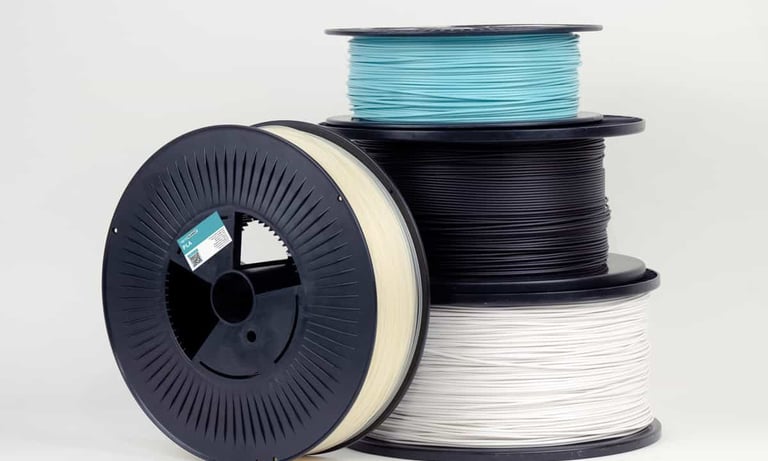Choosing the Right Filament for Your Project
3D Printing Tips and Tricks
DIGITAL MANUFACTURING
8/5/20244 دقيقة قراءة


Choosing the Right Filament for Your Project
Introduction
3D printing has revolutionized manufacturing, enabling the rapid prototyping and production of complex designs with relative ease. However, one of the most crucial aspects of achieving a successful 3D print is selecting the right filament for your project. With a plethora of filament types available, each with unique properties and applications, making the right choice can significantly impact the quality, durability, and functionality of your final product. This article will guide you through the key considerations for selecting the right filament for your 3D printing project.
1. Understand Your Project Requirements
Before diving into the different filament types, it’s essential to clearly understand your project requirements. Consider the following factors:
- Purpose: Is the printed object for prototyping, functional use, aesthetic display, or a combination of these?
- Environment: Will the object be exposed to heat, moisture, chemicals, or mechanical stress?
- Detail and Precision: Does your design require high detail and precision, or is it more about structural integrity?
2. Common Filament Types and Their Properties
a. PLA (Polylactic Acid)
Overview: PLA is one of the most popular filaments for beginners due to its ease of use and environmentally friendly properties.
Properties:
- Ease of Printing: Low printing temperature and minimal warping.
- Strength and Durability: Moderate strength and durability; not suitable for high-stress applications.
- Environmental Impact: Biodegradable and derived from renewable resources.
- Applications: Prototyping, toys, and decorative items.
b. ABS (Acrylonitrile Butadiene Styrene)
Overview: ABS is known for its toughness and impact resistance, making it ideal for functional parts and prototypes.
Properties:
- Ease of Printing: Requires higher printing temperatures and a heated bed to prevent warping.
- Strength and Durability: High strength and impact resistance; can withstand higher temperatures.
- Environmental Impact: Non-biodegradable and emits fumes during printing; proper ventilation is needed.
- Applications: Automotive parts, electronic housings, and toys.
c. PETG (Polyethylene Terephthalate Glycol)
Overview: PETG combines the ease of use of PLA with the durability of ABS, making it a versatile filament.
Properties:
- Ease of Printing: Moderate printing temperature with minimal warping; requires a heated bed.
- Strength and Durability: High strength, flexibility, and impact resistance; good for functional parts.
- Environmental Impact: Recyclable but not biodegradable.
- Applications: Mechanical parts, containers, and protective components.
d. TPU (Thermoplastic Polyurethane)
Overview: TPU is a flexible filament known for its elasticity and resilience.
Properties:
- Ease of Printing: Requires slower print speeds and careful temperature control.
- Strength and Durability: Highly flexible and durable; excellent wear and tear resistance.
- Environmental Impact: Non-biodegradable.
- Applications: Phone cases, gaskets, and wearable items.
e. Nylon
Overview: Nylon is a strong, durable filament ideal for industrial applications.
Properties:
- Ease of Printing: Requires high printing temperatures and a heated bed; prone to moisture absorption.
- Strength and Durability: High strength, durability, and flexibility.
- Environmental Impact: Non-biodegradable and moisture-sensitive.
- Applications: Mechanical components, gears, and tools.
3. Specialty Filaments
In addition to standard filaments, there are specialty filaments designed for specific applications:
a. Carbon Fiber Reinforced Filaments
- Properties: Enhanced strength and rigidity; lightweight.
- Applications: Aerospace, automotive, and high-stress applications.
b. Wood Fill Filaments
- Properties: Aesthetic appeal of wood; can be sanded and stained.
- Applications: Decorative items, furniture prototypes.
c. Metal Fill Filaments
- Properties: Appearance and some properties of metal; heavier and more rigid.
- Applications: Jewelry, artistic pieces, and prototypes requiring metal-like appearance.
4. Tips for Choosing the Right Filament
a. Match Filament Properties to Project Needs
Ensure the filament’s properties align with your project’s requirements, such as strength, flexibility, and temperature resistance.
b. Consider Printer Compatibility
Check your 3D printer’s specifications to ensure compatibility with the chosen filament type, especially regarding extrusion temperature and bed requirements.
c. Evaluate Printability
Consider the ease of printing, especially if you are a beginner. Some filaments, like PLA, are more forgiving and easier to work with than others like ABS or Nylon.
d. Factor in Environmental and Health Considerations
Be mindful of the environmental impact and health considerations, such as the need for ventilation when printing with certain filaments like ABS.
Conclusion
Choosing the right filament for your 3D printing project is crucial for achieving the desired outcome. By understanding your project requirements and the properties of different filaments, you can make an informed decision that ensures your final product is both functional and high-quality. Whether you’re a hobbyist, a student, or a professional, the right filament choice can make all the difference in your 3D printing endeavors.


TechBots
14 JULY 2024 5 MIN READ
TechBots
14 JULY 2024 4 MIN READ
Student Project Ideas
3D Printing Tips and Tricks





